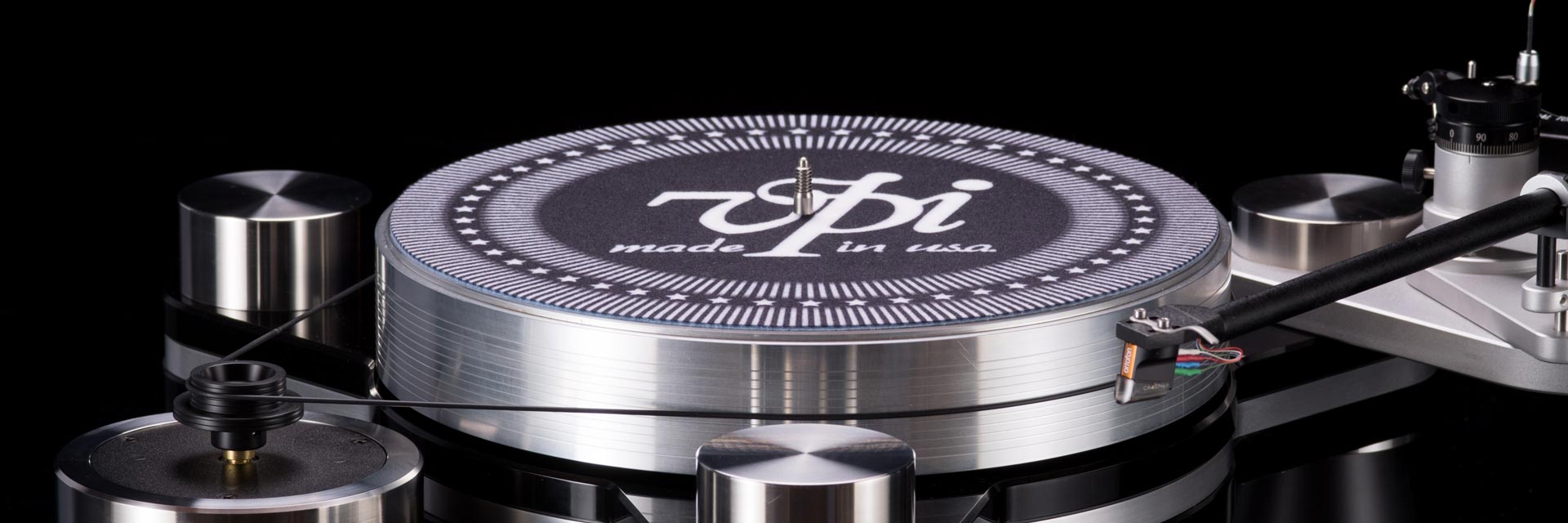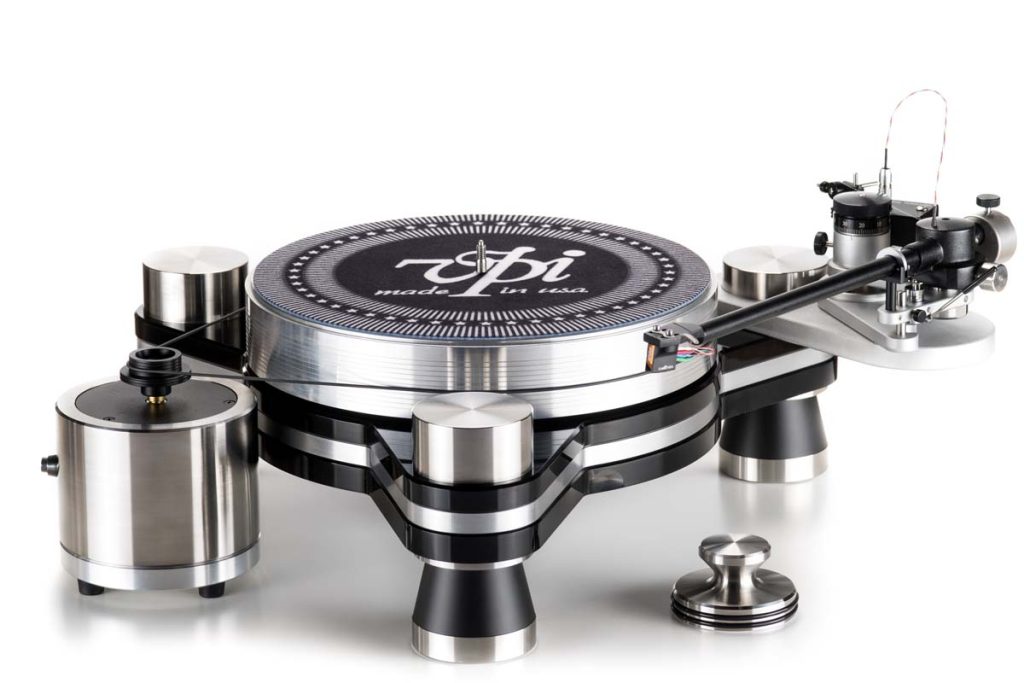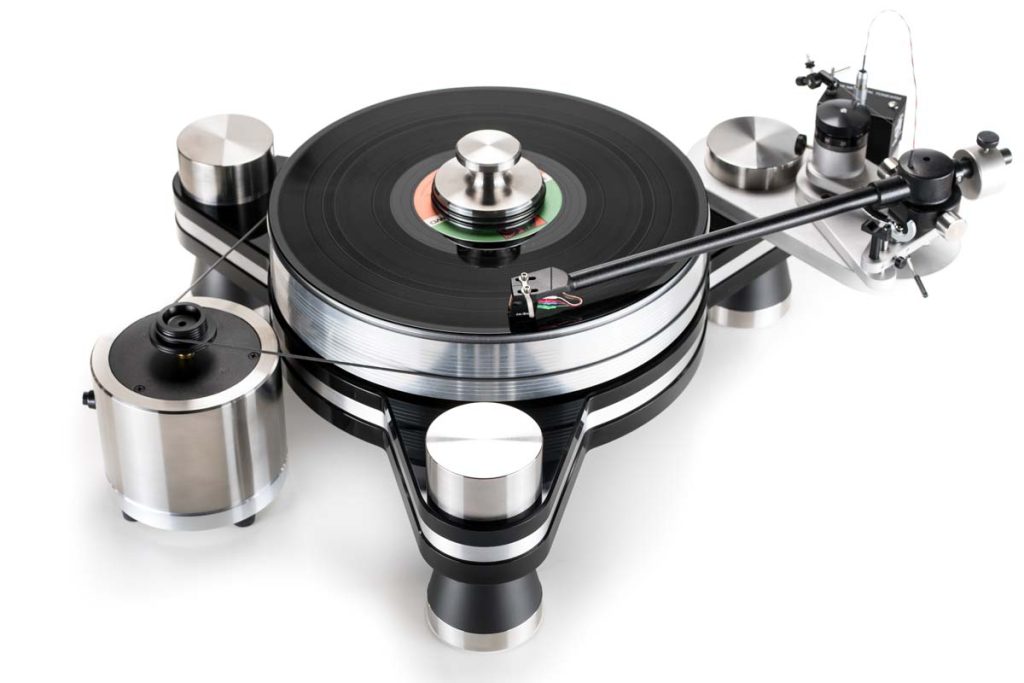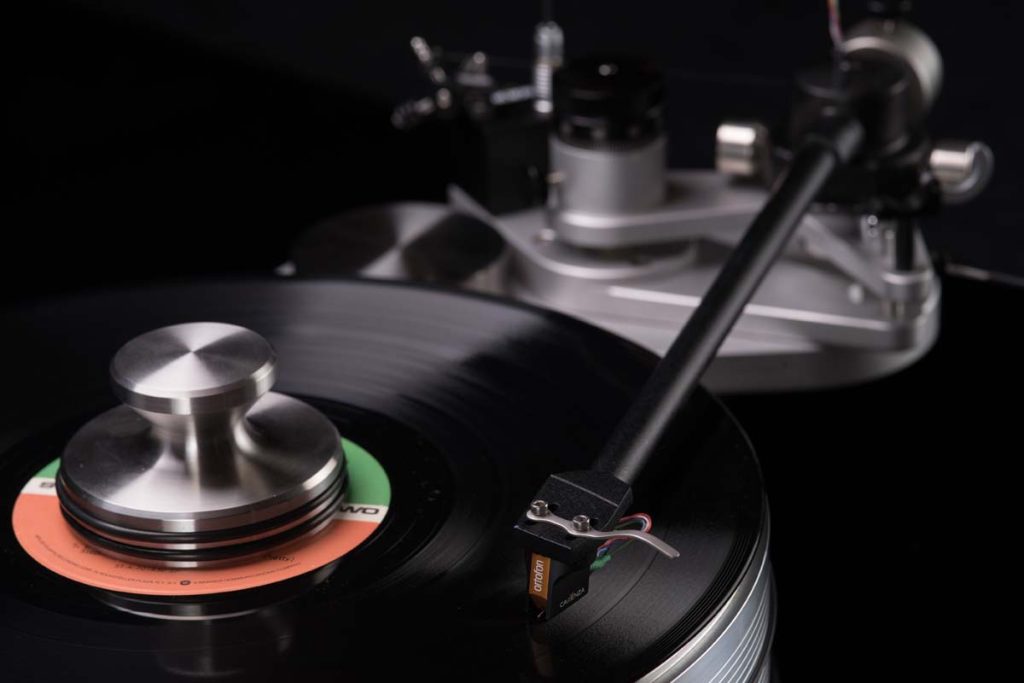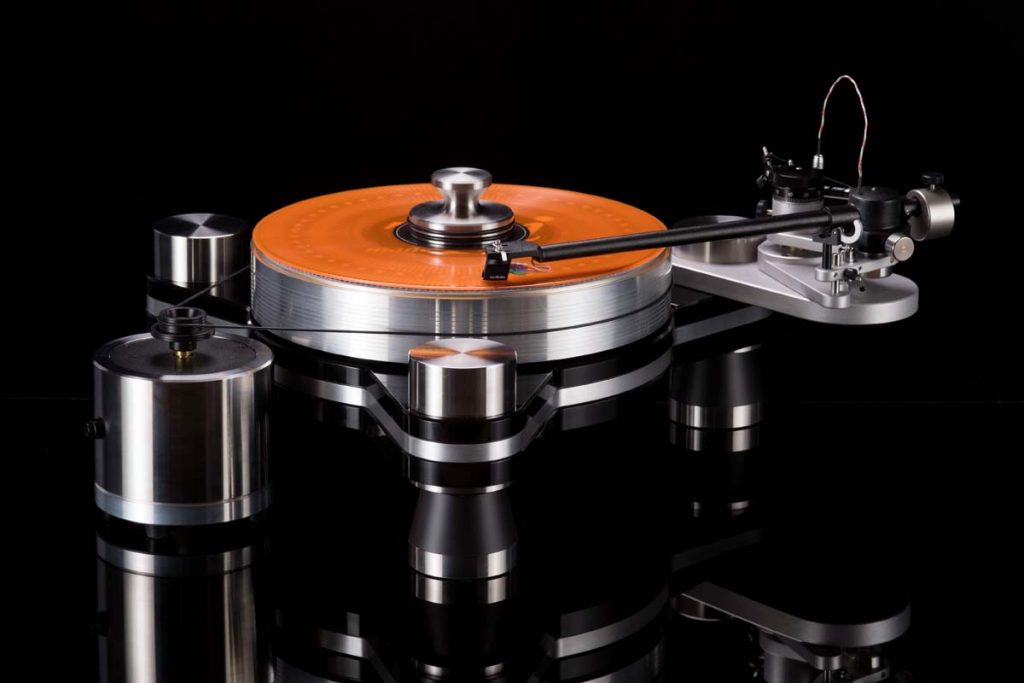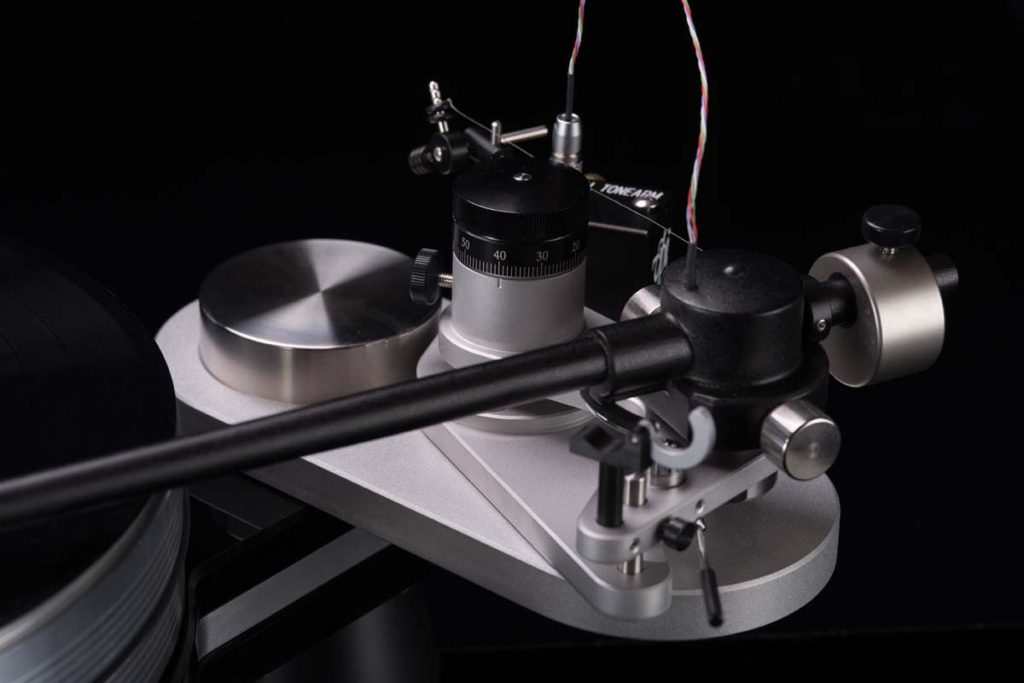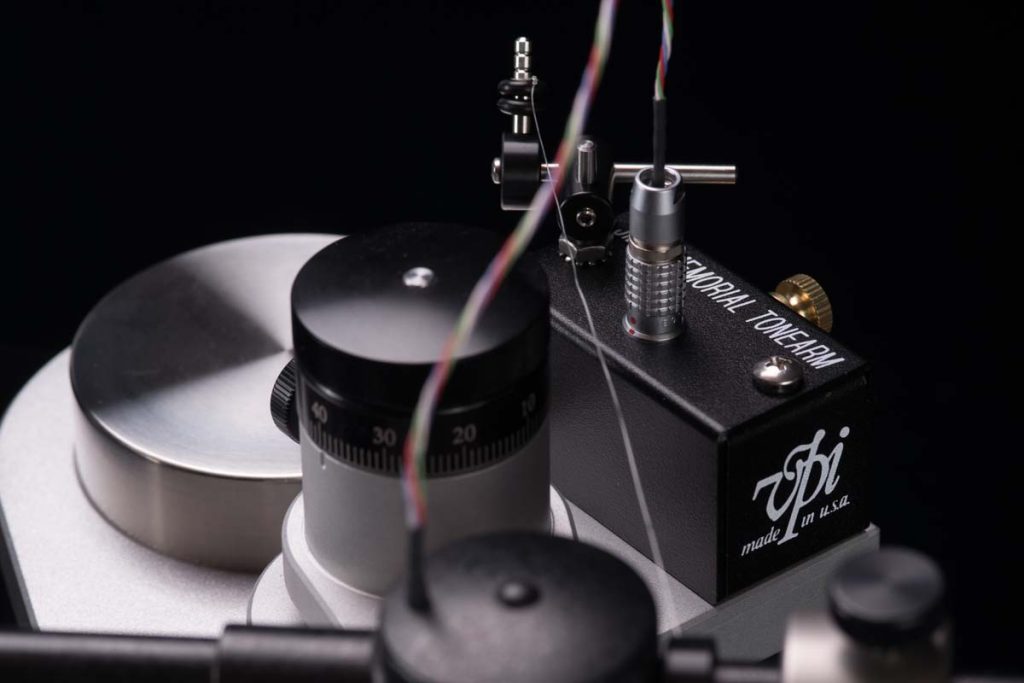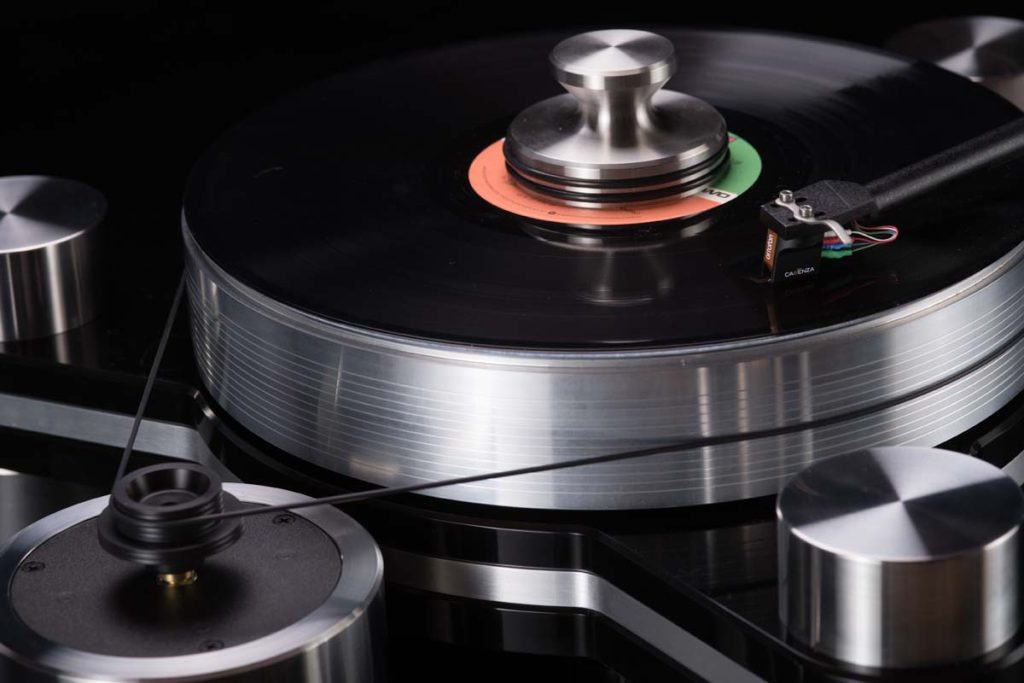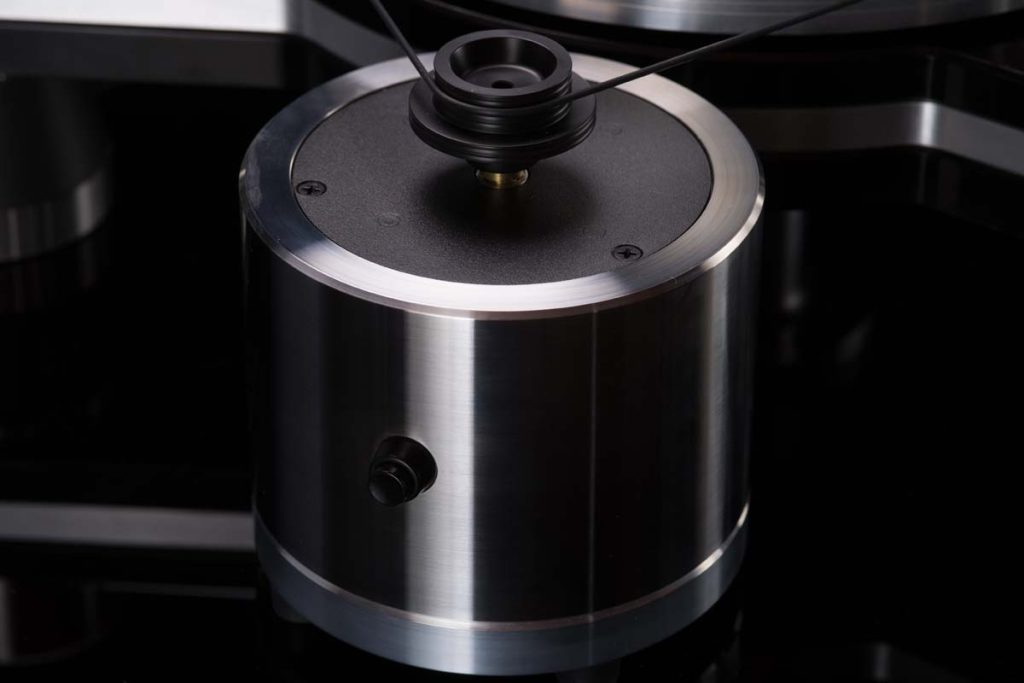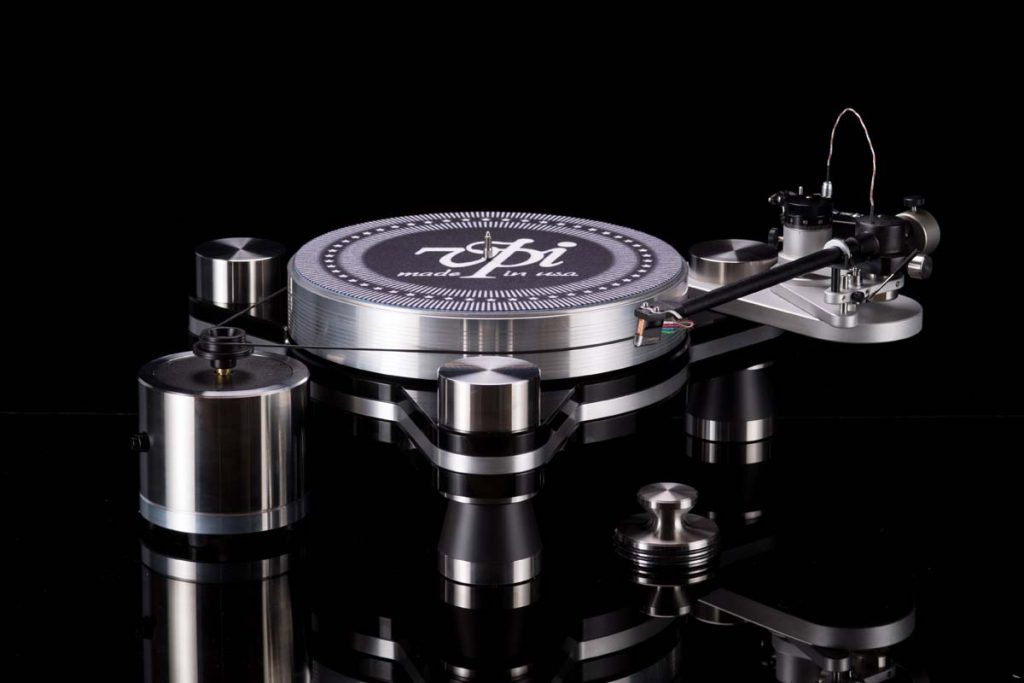It’s all in the mix: In addition to sophisticated technology, VPI relies on a smart combination of different materials for its turntables. Even the smallest Avenger is a feast for eager material researchers.
The Avengers is the name of Marvel’s science fiction film series, in which the character of Captain America is one of the superheroes. With his shield made of the miracle material “Vibranium”, he protects the world from villains and other spoilers. Whether the naming and shape of the VPI Avenger is due to the comic hero with his distinctive round shield remains a matter of speculation. What is certain, however, is that the material used by the American family-owned VPI Industries for their turntable named “Avenger” is a pretty real sandwich of three layers of acrylic/aluminum/acrylic glued together with damping material between the layers and is guaranteed not to vibrate.
Three stainless steel columns, to each of which tonearm bases can be flanged, protrude prominently from the chassis and form the receptacles for the Avenger’s three stand-up feet on the other side. These feet, made of aluminum and Delrin, are relatively softly screwed to the chassis with a special damping insert. This allows the turntable to be aligned plane-parallel on its footprint, which is a prerequisite for optimal performance. The 10-kilogram aluminum platter sits on a fairly large chrome-hardened steel ball that spins in a phosphor bronze bushing, with the bushing in turn located at the end of the inverted bearing made from a stainless steel shaft. On top of the platter is a two-layer felt mat with VPI logo. The 24-pole AC synchronous motor sits in a separate steel motor box weighing about 3 kilograms, also in a visually matching cylindrical shape, which is placed next to the Avenger and decoupled with rubber feet.
The drive belt is located at the height of the bearing to avoid tilting effects. The tolerances of the drive-related components are in the hundredths of a millimeter range or even tighter, as in the case of the motor pulley, which should guarantee exceptionally smooth running. All in all, the Avenger weighs a hefty 30 kilograms in this “smallest” configuration stage and lightens the wallet by a whopping 18,990 euros in return. An upgrade to the Plus and Reference versions includes, among other things, a friction wheel drive with separate motor control, magnetic damping for the turntable and more elaborately decoupled feet, as well as an upgrade of the tonearm. The concept of the Avenger was conceived by company founder Harry Weisfeld more than 15 years ago, but was not realized until about five years ago due to a heavy workload with other projects. With this in mind, the VPI Avenger can be considered a mature design and a long-term investment in high-end music playback.
Length runs
Length runs, say the sailors, and this thought immediately comes to mind with the 12-inch tonearm JMW 12 3D. According to this, longer or slimmer shapes run faster and more true to track, but on the other hand they are not as maneuverable. Anyone who has ever sailed on a sailing ship knows very well that the prerequisite for making progress is optimum sail trim, i.e. the best possible ratio of resistance to propulsion. To get the opposing properties in balance, minimizing the contact area and lightweight construction helps, as practiced in the renovated JMW tonearm with the latest 3D printing technology. It is a so-called Uni-Pivot, i.e. single-point mounted tonearm, which was designed for minimal friction and optimal balance. To make this particularly easy, the original metal tube was replaced with an epoxy resin composite. It is manufactured using a 3D printing process that allows seamless conical contours to be produced with uniform material properties, which should help to ensure consistent vibration behavior and thus low interference.
Headshell, tonearm tube and bell are printed in this process, virtually “from one cast”, with the integrated metal inlays such as bearing mirrors and lateral metal cantilevers for azimuth balance. The tonearm cable, here in the standard version made of pure copper wire, is led out of the bell and connected to the RCA connection box on the tonearm base by means of a Lemo plug. Optionally, the tonearm is also available in a version with northeast wiring and additional CFRP jacket. An asymmetrical metal tonearm weight is attached to the rear end of the tonearm tube and fixed with a screw. The center of gravity is thus shifted downwards towards the needle tip, which again contributes to good balance. The tonearm can be easily changed or simply placed on the height-adjustable tungsten carbide bearing tip and very sensitively brought into balance or, to stay in the picture, optimally trimmed for the analog “swell”. This may seem unusually wobbly at first, but one notices very quickly the enormous stability and ease in handling the tonearm, once it is brought into balance. This is also due to the stately base made of a high-strength aluminum alloy, which is constructed in three layers, so that the arm can be varied in height via a sensitive rotary wheel – and that during ongoing play. For stabilization, another pin is inserted between the tonearm lock and lift, which fixes the boom when the optimum height with respect to the vertical scanning angle (VTA) is found. The effort is worthwhile, especially with 12-inch tonearms, because with increasing length, misalignments at the base also have a more serious effect on the needle tip.
When adjusting the 12-inch, I was nevertheless initially a bit on the tube, because even only in the possession of setting templates of shorter tonearms. The enclosed adjustment gauge with the name “JMW Alignment” seemed to me at first too simple for my needs and the adjustment possibilities of the tonearm. In the absence of a short-term alternative, I then tried the gauge – and lo and behold, with knowledge of the required pivot spindle distance of 300 millimeters, the pickup can be set sufficiently accurately via the engraved line pattern including the needle contact point. The tracking force, VTA and azimuth can then be optimally fine-tuned using the many adjustment options. Antiskating is realized classically by means of thread and a clever deflection rotor, if desired. Because almost all parameters can be freely adjusted in relation to each other, however, inexperienced users can easily get lost here. First of all, the tonearm base should be attached to the turntable in such a way that the tonearm has a suitable horizontal position to the turntable, where you want to place the needle. The tonearm weight is relatively easy to adjust and not always quite symmetrical to get into position. It has been shown, however, that the balance can be optimized later more easily by the lateral outriggers – it’ one of those cases where several ways lead to the goal.
Surfing the waves
The JMW 12 3D tonearm feels unusually light when I bring it into the start position for the album I have put on. The 3D tonearm available to me has no finger bar, so I touch and feel the headshell and tonearm tube directly. The surface is textured and doesn’t feel metallic cool at all; this is new to me, but well done and solid. I installed my Genuin Sting cartridge in the headshell, a combination of a Denon DL-103 with a Van den Hul needle, tonally a very good compromise of gripping playability and good resolution. As soon as the needle dips into the groove, the single point driver quickly stabilizes itself, the balance is right. Perhaps due to the chosen configuration, Sting’s new studio album The Bridge (his fifteenth) comes to mind first. To my taste, musically one of his best albums, and sonically it is excellent as well. What is in the good old vinyl record musically and sonically, is sometimes inconceivable to me, the VPI Avenger provides the musician Sting the appropriate stage. The voice of Sting is audibly aged, but in my opinion also matured, is more multifaceted and plays very harmoniously together with the excellent instrumentalists, as there are Dominic Miller, Branford Marsalis or Manu Katché. The low end is punchy, dry and immediately gets to the point.
It seems to me that someone has extended the stage a bit to include the frequency basement. Switching to my subchassis turntable, this extended frequency range of the Avenger is immediately clearly audible. The overall musical impression cannot be shifted in favor of my comparison turntable by an even more exclusive cartridge from my range, such as the Lyra Kleos, or a particularly good phono preamplifier, such as from Canor or Cyrus. On the contrary, in this particular case, my relatively less expensive Trichord Dino with auxiliary power supply is perfectly sufficient for the Avenger to conjure up a very playable and yet natural sound image in my listening room. Reassuring for me is the fact that it is not different sound worlds that make music here in comparison. It is also not important to put together the most expensive components, you have to tune your system to each other just as you are used to doing with different musicians or instruments. Conversely, the question naturally arises: Is this relatively large investment in a turntable like the VPI Avenger worth it? The answer is a resounding yes, because it simply makes the sound more natural, and this can only be compensated for elsewhere with considerable effort, if at all. With this in mind, the VPI Avenger could already be described as something like an analog superhero, perhaps from a different era, but certainly more current than ever before.
Accompanying Equipment
Turntable: Avid Diva SP | Tonearm: Origin Live Illustrious | Pickup: Lyra Kleos | Phono pre: Cyrus Phono Signature | Amplifier: MFE TA 211 V | Loudspeakers: Blumenhofer Tempesta 20
Turntable
VPI Avenger
Concept: Non-suspended turntable with sandwich plinth (acrylic/aluminum/acrylic) and high-precision motor, accommodates up to three tonearms | Motor: AC synchronous motor running at 300 rpm, tolerance ± 0.005″ | Platter: Aluminum (diameter: 12″; weight: 10 kg) | Dimensions (W/H/D): 69/25/58 cm (Footprint 58 x 50 cm) | Weight: 34 kg | Warranty period: two years | Price: 18 990 Euros and up (including tonearm JWM 12 3D)
Audio Reference GmbH
Alsterkrugchaussee 435
22335 Hamburg
Telefon +49 40 53320359
info@audio-reference.de

